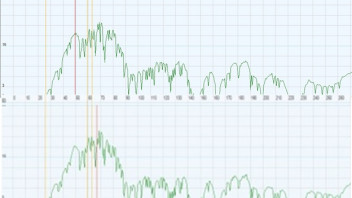I continue to try and understand some of the results presented by Wyttenbach in his most recent ResearchGate posting (A new experimental path to nucleosynthesis)
I have had trouble understanding the nature of the gamma spectra displayed in this work. In particular, in thinking about things, I don't understand why the noise in some spectra seems so low. Figure 1, for instance, shows background-subtracted spectra at 250C (top, below) and 380C (bottom, below). Both spectra are taken over 10 minutes.

What we see here is a remarkable similarity between the 2 spectra. They are not identical -- after all they are taken at different times and different temperatures -- but for the most part the bumps and valleys in the top spectrum also occur in the bottom one. The similarity does not just consist in the 2 spectra showing mainly the same peaks (which is OK), but in the peaks being the same height n both spectra. Indeed, if you superimpose these traces they fit over top of each other very closely at many many points.
My puzzlement here is that the event count in each bin of a spectrum should be roughly Poisson distributed (due to the random timing of gamma events). Following from this, the standard deviation of counts in each bin should be about the square root of the count number itself. Thus if we were to acquire the same spectrum again (over a similar interval) the count number in each bin should differ slightly from the first values. And, if we acquired and reacquired the same spectrum over and over, we should find that the count in any bin should vary with the square root of the mean count as just noted.
Now, look at the red vertical line in the top spectrum (at about 49 keV). It happens to lie near the peak of a feature that is also present in the lower spectrum. In the top spectrum, the bin count at 49 keV is (estimating by eye) 19. In the bottom spectrum the bin count is about 18. These count values are close. Too close by my reckoning! I calculate that the standard deviation of counts at this energy should be about 5.5 (because total counts at this energy [background + signal] is 30 counts and the square root of 30 is about 5.5). In light of this, the 1-count difference between the upper and lower spectra at this energy is statistically unlikely.
You can repeat this observation for any energy shown in Figure 1 and get the same result. The difference between the 2 spectra at most energies is many times smaller than expected. So this is not just a statistical fluke that happens to occur at 49 keV. It is at all energies. And I don't understand why this is. Wyttenbach says a (undescribed) smoothing algorithm has been used before displaying the spectra, but it is not immediately apparent to me how this could account for such a radical reduction in variation between them.
Does anyone know what might be going on?
